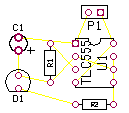
| Key Features of CIRCAD |
 |
Schematic Capture
To design a schematic, simply open a schematic drawing sheet and start placing components. Connect them together using wires, buses,
and signal ports. More complex circuits may require a multi-sheet schematic -- also easily accomplished with one set of signal names
common to all schematic sheets.
Netlist Generation
After a schematic is complete (or complete enough), all component and interconnection data is compiled and written to disk as a
netlist file. Multi-sheet schematics will produce multiple netlists that will be merged by the PCB editor.
PCB Layout
While slurping in the netlist, CIRCAD will automatically select the components from the various library files and line them up along the
bottom of the board file. If a component already exists from a previous design cycle, its parameters will be updated to reflect the new
information. The components must be manually positioned into the desired locations for each individual part. A ratsnest of interconnections
may be used to aid in component placement. Although routing of the necessary signal tracks is best done manually, an autorouter is
available to assist with the simpler and more tedious operations such as SMT power/ground fanout.
Copper Pour
While multi-layer PCBs rely on unbroken power and ground planes on internal layers, simple two-sided boards must be painstakingly flooded
with copper to fill all areas not occupied by pads and signal tracks. CIRCAD can flood into restricted areas and has individual clearance
parameters for each of the different element types.
Design Rule Checking (DRC)
The DRC function will enable the designer to verify the correctness of a circuit's interconnections and ensure adequate clearances between
the various elements.
Manufacturing Output Formats
CIRCAD provides support for a number of different manufacturing output formats. The industry standard RS-274D (sometimes mis-labeled
RS-274X) Gerber files are used for sending data to the board manufacturers. Alternatively support is available for other CAD packages
such as Tango, Protel, and AutoCad. PCB assembly data is available as Bill of Material (BOM) output and IPC-D lists.
Producing PCBs using the milling method
CIRCAD can automatically "outline" your design with lines, arcs and circles allowing you to mill a prototype PCB from a sheet of copper.
Direct support for both the MicroKinetics and the T-Tech
Rapid PCB prototyping machines is available.
Standard component libraries
CIRCAD schematic symbol and PCB component package libraries contain all of the standard devices that are needed. User defined components
can easily be built and added to the library of available parts.
... and much much more!



